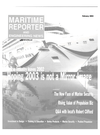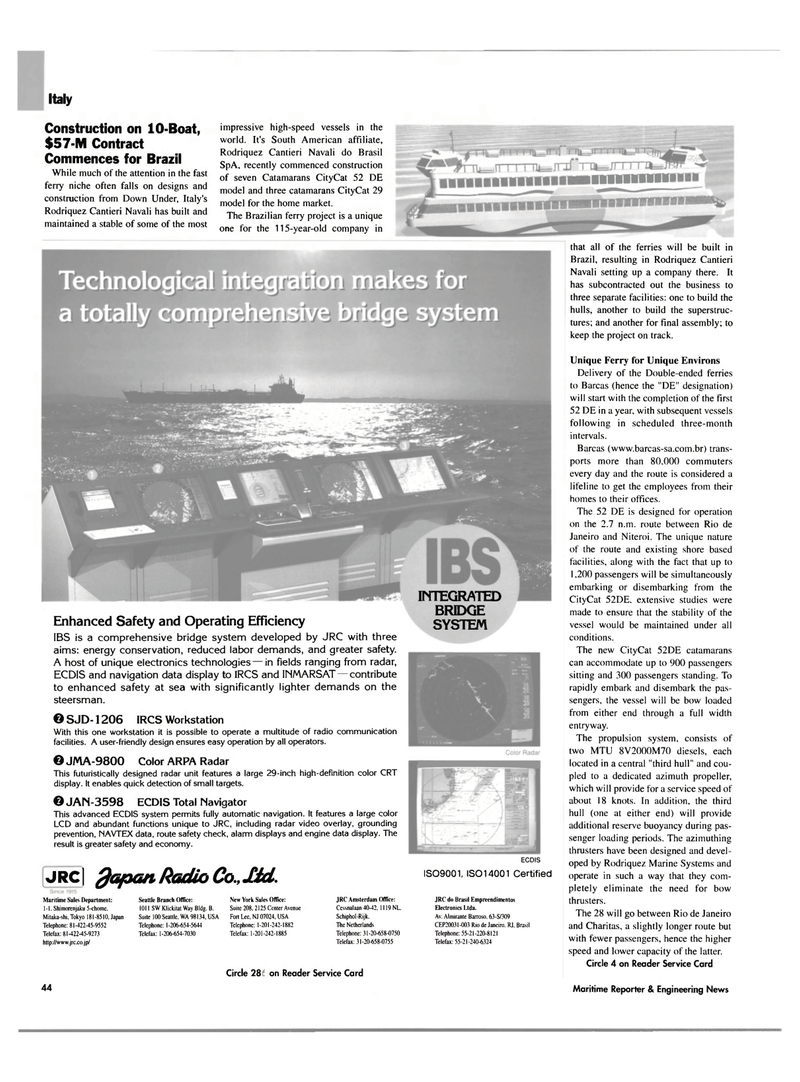
Page 44: of Maritime Reporter Magazine (February 2003)
Read this page in Pdf, Flash or Html5 edition of February 2003 Maritime Reporter Magazine
Italy
Construction on 10-Boat, $57-M Contract
Commences for Brazil
While much of the attention in the fast ferry niche often falls on designs and construction from Down Under, Italy's
Rodriquez Cantieri Navali has built and maintained a stable of some of the most impressive high-speed vessels in the world. It's South American affiliate,
Rodriquez Cantieri Navali do Brasil
SpA, recently commenced construction of seven Catamarans CityCat 52 DE model and three catamarans CityCat 29 model for the home market.
The Brazilian ferry project is a unique one for the 115-year-old company in
Enhanced Safety and Operating Efficiency
IBS is a comprehensive bridge system developed by JRC with three aims: energy conservation, reduced labor demands, and greater safety.
A host of unique electronics technologies in fields ranging from radar,
ECDIS and navigation data display to IRCS and INMARSAT — contribute to enhanced safety at sea with significantly lighter demands on the steersman. © SJD-1206 IRCS Workstation
With this one workstation it is possible to operate a multitude of radio communication facilities. A user-friendly design ensures easy operation by all operators. © JMA-9800 Color ARPA Radar
This futuristically designed radar unit features a large 29-inch high-definition color CRT display. It enables quick detection of small targets. © JAN-3598 ECDIS Total Navigator
This advanced ECDIS system permits fully automatic navigation. It features a large color
LCD and abundant functions unique to JRC, including radar video overlay, grounding prevention, NAVTEX data, route safety check, alarm displays and engine data display. The result is greater safety and economy.
INTEGRATED
BRIDGE
SYSTEM W
JRC[ flapanRadio Co., JUd.
Maritime Sales Department: 1-1, Shimorenjaku 5-chome,
Mitaka-shi, Tokyo 181-8510, Japan
Telephone: 81-42245-9552
Telefax: 81422-45-9273 http://www.jrc.co.jp/
Seattle Branch Office: 1011 SW Klickitat Way Bldg. B.
Suite 100 Seattle. WA 98134, USA
Telephone: 1-206-654-5644
Telefax: 1-206-654-7030
New York Sales Office:
Suite 208, 2125 Center Avenue
Foil Lee, NJ 07024, USA
Telephone: 1-201-242-1882
Telefax: 1-201-242-1885
JRC Amsterdam Office:
Cessnalaan 4042. 1119 NL,
Schiphol-Rijk.
The Netherlands
Telephone: 31-20-658-0750
Telefax: 31-20-658-0755
ECDIS
IS09001, IS014001 Certified
JRC do Brasil Empreendimentos
Electronics Ltda.
Av. Almirante Bairoso, 63-S/309
CEP2003I-003 Rio de Janeiro. RJ. Brasil
Telephone: 55-21-220-8121
Telefax: 55-21-240-6324
Circle 218 on Reader Service Card that all of the ferries will be built in
Brazil, resulting in Rodriquez Cantieri
Navali setting up a company there. It has subcontracted out the business to three separate facilities: one to build the hulls, another to build the superstruc- tures; and another for final assembly; to keep the project on track.
Unique Ferry for Unique Environs
Delivery of the Double-ended ferries to Barcas (hence the "DE" designation) will start with the completion of the first 52 DE in a year, with subsequent vessels following in scheduled three-month intervals.
Barcas (www.barcas-sa.com.br) trans- ports more than 80.000 commuters every day and the route is considered a lifeline to get the employees from their homes to their offices.
The 52 DE is designed for operation on the 2.7 n.m. route between Rio de
Janeiro and Niteroi. The unique nature of the route and existing shore based facilities, along with the fact that up to 1,200 passengers will be simultaneously embarking or disembarking from the
CityCat 52DE. extensive studies were made to ensure that the stability of the vessel would be maintained under all conditions.
The new CityCat 52DE catamarans can accommodate up to 900 passengers sitting and 300 passengers standing. To rapidly embark and disembark the pas- sengers, the vessel will be bow loaded from either end through a full width entryway.
The propulsion system, consists of two MTU 8V2000M70 diesels, each located in a central "third hull" and cou- pled to a dedicated azimuth propeller, which will provide for a service speed of about 18 knots. In addition, the third hull (one at either end) will provide additional reserve buoyancy during pas- senger loading periods. The azimuthing thrusters have been designed and devel- oped by Rodriquez Marine Systems and operate in such a way that they com- pletely eliminate the need for bow thrusters.
The 28 will go between Rio de Janeiro and Charitas, a slightly longer route but with fewer passengers, hence the higher speed and lower capacity of the latter.
Circle 4 on Reader Service Card 44 Maritime Reporter & Engineering News

 43
43

 45
45
